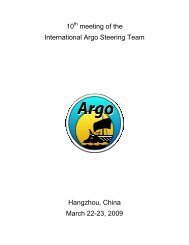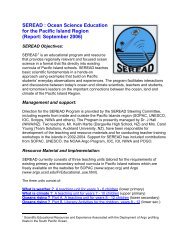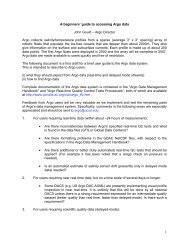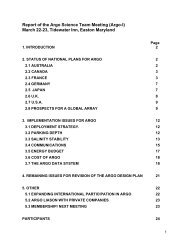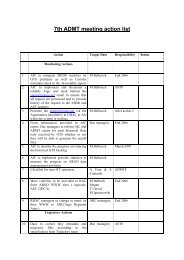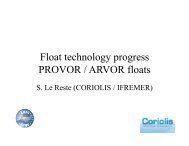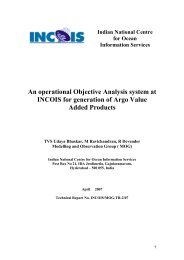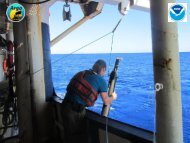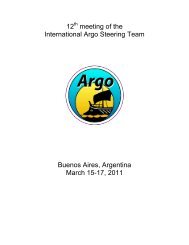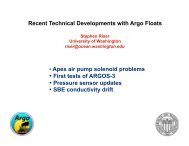11 meeting of the International Argo Steering Team Scripps ...
11 meeting of the International Argo Steering Team Scripps ...
11 meeting of the International Argo Steering Team Scripps ...
You also want an ePaper? Increase the reach of your titles
YUMPU automatically turns print PDFs into web optimized ePapers that Google loves.
For each potential TNPD microleakers, <strong>the</strong> time series <strong>of</strong> <strong>the</strong> differences is plotted to look for<br />
evidence <strong>of</strong> <strong>the</strong> Druck microleak (cold bias in strong <strong>the</strong>rmocline, saline anomaly at depth and<br />
negative anomaly for <strong>the</strong> pressure).<br />
The method is clearly able to detect APEX TNPD microleakers. Large drifts are obvious.<br />
Complementary diagnostics are required to detect smaller drifts. Using ADJUSTED data and<br />
excluding suspicious floats from <strong>the</strong> analysis should help refine <strong>the</strong> detection <strong>of</strong> <strong>the</strong> TNPD<br />
microleakers.<br />
Action item 10: Ask CSIRO to redo <strong>the</strong>ir comparisons to look at buddy pairs by launch<br />
year to help identify possible errors in pressure by year for a correction or error to add<br />
into files.<br />
5.2.3 Progress on <strong>Argo</strong> Reference Database<br />
S Diggs was unable to attend <strong>the</strong> AST-<strong>11</strong> <strong>meeting</strong>, so <strong>the</strong> status report on <strong>the</strong> current state <strong>of</strong><br />
<strong>the</strong> acquisition and dissemination <strong>of</strong> Ship-Based CTD data was presented by M Scanderbeg.<br />
After briefly reviewing <strong>the</strong> original need for <strong>the</strong>se data and <strong>the</strong> tri-agency structure <strong>of</strong> <strong>the</strong> CTD<br />
data acquisition team, recent work by J Gilson, M Scanderbeg and S Diggs was shown. The<br />
most recent CTD database (CTD_for_DMQC_2010V1) and <strong>the</strong> “<strong>Argo</strong> Float” database<br />
(<strong>Argo</strong>_for_DMQC_2009V4) were used within <strong>the</strong> Owens and Wong (OW) salinity calibration tool<br />
to ‘map’ <strong>the</strong> climatology <strong>of</strong> <strong>the</strong> South Pacific and Sou<strong>the</strong>rn Oceans. This analysis attempts to<br />
quantify those regions where new CTD data are most necessary to improve <strong>the</strong> <strong>Argo</strong> DMQC<br />
reference database (CTD) and simultaneously to confirm ocean state changes measured by <strong>the</strong><br />
<strong>Argo</strong> float database.<br />
In addition, <strong>the</strong> presentation included a Google Earth animation highlighting <strong>the</strong> lack <strong>of</strong> publicly<br />
available CTD pr<strong>of</strong>iles in <strong>the</strong> Sou<strong>the</strong>rn Ocean in <strong>the</strong> last ten years. However, <strong>the</strong> CCHDO's<br />
involvement in <strong>the</strong> US Repeat Hydrography Program as well as <strong>the</strong> new GO-SHIP project will<br />
give <strong>the</strong> <strong>Argo</strong> data team rapid access to a significant number <strong>of</strong> high-quality CTD data from<br />
research cruises scheduled in <strong>the</strong> coming months and years. Unfortunately, identifying<br />
temporally relevant CTD observations data from <strong>the</strong> Sou<strong>the</strong>rn Indian Ocean continues to be a<br />
challenge. Fur<strong>the</strong>r direction and feedback from <strong>the</strong> <strong>Steering</strong> <strong>Team</strong> would help <strong>the</strong> Data <strong>Team</strong><br />
continue to refine its objectives and insure success with this project.<br />
5.2.4 O<strong>the</strong>r reports and open discussion on pressure issues<br />
S Wijffels reported on an analysis by CSIRO <strong>of</strong> pressure adjustments in <strong>the</strong> <strong>Argo</strong> APEX data set<br />
downloaded from <strong>the</strong> GDACs in December 2008. This analysis is currently in review, and is<br />
focused on producing a version <strong>of</strong> <strong>the</strong> <strong>Argo</strong> data set appropriate for studying changes in global<br />
ocean heat content (GOHC). It was noted that as <strong>the</strong> pressure sensors deployed in <strong>Argo</strong> has<br />
changed over time, <strong>the</strong> bias in <strong>the</strong> DAC data set has changed. Early float sensors (Ametek and<br />
Paine) typically drifted positive while Druck sensors typically have little drift or strong negative<br />
drift (when afflicted by a micro-leak) – figure X.<br />
15



